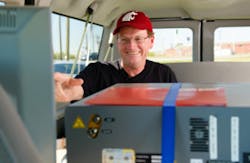Brian Lamb doing field work on the methane emissions study. (Photo credit: WSU)
A team led by Washington State University researchers has found that methane emissions from local natural gas distribution systems in cities and towns throughout the U.S. have decreased in the past 20 years with significant variation by region.
The researchers found that upgrades in metering and regulating stations, changes in pipeline materials, better instruments for detecting pipeline leaks as well as regulatory changes have led to methane emissions that are from 36 percent to 70 percent lower than Environmental Protection Agency (EPA) estimates when the data gathered for this study are combined with pipeline miles and number of facilities.
The study showed significant variation by region, with some areas showing higher than average emissions because of large differences in the age and type of pipe in different parts of the U.S.
The study, published in Environmental Science & Technology, provides the most comprehensive direct measurements yet of emissions from the distribution system. With a series of partner studies, it is helping to determine the natural gas industry’s contribution to U.S. greenhouse gas emissions and global warming.
The distribution system includes underground natural gas pipelines as well as metering and regulating facilities and customer meters in cities and towns.
The research was led by Regents Professor Brian Lamb in WSU’s Laboratory for Atmospheric Research with assistance from Conestoga-Rovers and Associates, an engineering and environmental consulting firm.
The researchers found dramatically lower emissions at metering and regulating stations. In fact, because of the significant differences they saw from the early 1990s data, the researchers revisited nine sites from the previous study. They measured 10 times fewer emissions than 20 years ago.
They also measured lower emissions from individual pipeline leaks compared to earlier studies. The improvements are the result of both regulatory changes and increased investment in leak prevention by utilities.
READ ALSO: Legislating Enhanced Leak Detection & Repair
When the new emissions data were combined with current pipeline mileage information, significant regional variations were observed. The eastern region of the United States accounted for more than a third of the total U.S. emissions from pipeline leaks. The western region, where systems tend to be newer, contributed 17 percent of total emissions.
Natural gas, which is mostly methane, produces less carbon dioxide than oil or coal. But when unburned methane is released into the atmosphere, it is a potent greenhouse gas with a warming potential 28 to 34 times greater than carbon dioxide over a 100-year timeframe (and up to 84 times more potent over a 20-year timeframe). Depending on how much is emitted from the natural gas supply chain, methane could offset the benefit of using natural gas to reduce carbon dioxide emissions.
As part of the study, the research team carefully selected numerous sites in various regions around the country that met specific criteria to ensure a comprehensive and representative dataset. The researchers took direct emissions measurements of 230 randomly selected, representative leaks from underground pipelines. They took measurements at 229 metering and regulating stations where natural gas is measured and regulated from higher pressure pipelines to lower pressure distribution pipelines.
The researchers estimate that methane emissions from the distribution system range from approximately 393 to 854 gigagrams per year, which is between 0.1 and 0.2 percent of the methane delivered nationwide. This is equivalent to the annual greenhouse gas emissions of about 7 million vehicles.
The higher EPA estimates of 1,329 gigagrams are based largely on previous measurements from a national study in the early 1990s in which Lamb and his colleagues also participated.
Lamb’s methane emissions project is part of a group of ongoing studies looking at the entire natural gas supply chain, from production wells to the transmission pipeline system to local distribution systems. EPA inventory data suggest that emissions from local distribution systems are thought to make up approximately 20 percent of the total from the natural gas supply chain.
The WSU study was done in coordination with major natural gas utilities and the Environmental Defense Fund (EDF) and was sponsored by the American Gas Association, Con Edison, EDF, National Grid, Pacific Gas & Electric and Southern California Gas.
Lamb was surprised by the findings, even as distribution system pipeline mileage has increased approximately 44 percent since the 1990s. He attributes the decreased emissions at metering facilities to changes in equipment and better inspection and maintenance.
In recent years, new EPA rules have required gas companies to measure and report their greenhouse gas emissions. In addition, many states have adopted requirements and policies for utilities to replace older, leakier pipes with plastic and protected steel pipes.
The research group also used different methods than in the previous study, which Lamb believes resulted in a more accurate assessment of actual emissions. In the 1990s study, researchers measured pipeline leaks by digging down to a pipeline, isolating a leaking section, measuring the emissions and then subtracting the methane emissions that would have been lost in the soil via soil oxidation. Lamb’s group directly measured known pipeline leaks on the surface, getting a better indication of exactly how much is being leaked to the atmosphere.
The researchers also made twice as many measurements as in the previous study and checked their results with independent methods.
Source: By Tina Hilding, Voiland College of Engineering & Architecture, WSU



